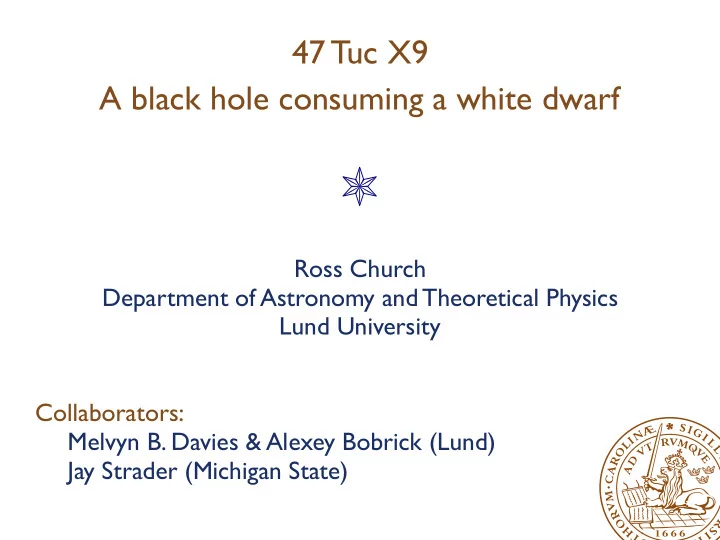

47 Tuc X9 A black hole consuming a white dwarf Ross Church Department of Astronomy and Theoretical Physics Lund University Collaborators: Melvyn B. Davies & Alexey Bobrick (Lund) Jay Strader (Michigan State)
Talk summary 47 Tuc X9 is a black hole devouring the remnants of a carbon-oxygen white dwarf Systems like 47 Tuc X9 do not form in the field, but can form dynamically in dense clusters The dynamical formation channel requires a third body and we might have seen a signal of its presence Bahramian et al. (2017) MNRAS 467 2199 Bobrick, Davies & RC (2017) MNRAS 467 3556 Church et al. (2017) ApJL 851 4
X-rays from 47 Tuc Chandra 0.3-10 keV Chandra 6-10 keV NuSTAR extraction region NuSTAR extraction region NuSTAR extraction region X9 is the brightest X-ray source in 47 Tucanae AKO 9 X9 X9 NuSTAR 3-78 keV 30" 30" NuSTAR 3-78 keV NuSTAR extraction region X-ray images from Bahramian et al . (2017) MNRAS 467 2199 Visual image: J Mack & ~30" G. Piotto, via Wikimedia Commons 30"
Ultra-compact X-ray binaries (UCXBs) Recap from Alexey's talk! M WD ≈ 0 . 01 M � Observed as bright X-ray sources; e.g. 4U 1820-30
Properties of 47 Tuc X9 No lines of H or He visible in spectrum Tudor et al. (2018) MNRAS 476 1889 28-minute periodicity in X-rays: orbital period? Bahramian et al . (2017) MNRAS 467 2199 7-day "super-orbital" period in X-ray and UV Bahramian et al . (2017), Tudor et al. (2018) Implies that 47 Tuc X9 is an ultra-compact X-ray binary with a carbon-oxygen white dwarf donor
But...
COWD-NS binaries do not form UCXBs! Specific angular momentum lost in mass transfer SPH result Unstable Stable WD mass Bobrick, Davies & RC (2017) MNRAS 467 3556
X-ray vs radio emission 10 31 Quiescent/hard state BHs Candidate BHs identified via radio/X-ray flux ratio Hard state NSs 10 30 AMXPs 5-GHz radio luminosity (erg s − 1 ) tMSPs CVs 10 29 VLA J2130+12 V404 Cyg 10 28 M22 M62 XSS J12270-4859 47Tuc X9 AE Aqr 10 27 PSR J1023+0038 SS Cyg 10 26 10 25 10 29 10 30 10 31 10 32 10 33 10 34 10 35 10 36 10 37 10 38 10 39 1-10 keV X-ray luminosity (erg s − 1 ) Bahramian et al . (2017) MNRAS 467 2199
WD-BH mass transfer stability 1 Defaults f Edd = 10 Unstable f Edd = 10, R CE = 3 a 0 . 8 f Edd = 10, R CE = 3 a , N CE = 10 8 f Edd = 100 M WD , crit / M � 0 . 6 0 . 4 0 . 2 Stable 0 0 5 10 15 20 N WD M • / M � Moderately efficient accretion permits WD-BH UCXBs RC et al. (2017) ApJL 851 4
But...
BH-WD UCXBs don't form in the field WD BH progenitor This mass transfer stage is stable: The orbit widens Form a non-interacting BH-WD binary
Making WD-BH binaries in clusters Collision-induced common-envelope evolution
Rate and properties calculation Fraction of BHs undergoing collision with an evolved star Z X Γ = 2 π Gf p f seg v − 1 n i [ M i ( t ) + M • ] R ? ,i ( t )d t, ∞ t i Tidal capture out to f p ≈ 3 giant radii Mass segregation increases rate by f seg ≈ 2 M • M ? , core α CE λ a f = R ? 2 M ? M ? , env take the common-envelope efficienc Assume a common-envelope-like process after collision Ivanova et al. (2010) ApJ 717 948 RC et al. (2017) ApJL 851 4
Collisionally-formed COWD-BH binaries 1000 AGB Need help 100 merging HB r peri / R � 10 Merge 1 0 . 3 0 . 4 0 . 6 1 M core / M � RC et al. (2017) ApJL 851 4
<latexit sha1_base64="U2Jd6RcxfPBF8oAE0CmXrjuWaIo=">AConicjVHbhMxEPUutxJuKTzywIiAxAOKvGmqpm8VBYGQCm0hTaU4rGa93sSqd72yvdBotR/Gb/DG3+DcpIJAYiRLZ+acMx6Pk1J6yj9GYTXrt+4eWvrduvO3Xv3H7S3H5ZXRkuhlwrbc4TtELJQgydEqcl0ZgnigxSi4OF/zoqzBW6uKzm5dikuO0kJnk6Hwpbn9nmUFeR03da45iZh0aZuU0xy89YFiWRl/CSvLW0mlHBwFNfM5DB63Xgb4CqboUmbBhgAO5XTmW9k9DefXqX/r+V6DtgM0mxce5RS9vI0ZjrVLm53aDeifTqg4EF/d7AbebBDvWofoi5dRoes4zhu/2Cp5lUuCscVWjuOaOkmNRonuRJNi1VWlMgvcCrGHhaYCzuplytu4LmvpJBp40/hYFm96qgxt3aeJ16Zo5vZP7lF8W/cuHLZYFLoqycKPjqoqxS4DQs/gtSaQR3au4BciP9rMD9LpE7/6stv4TNS+Hf4KzXjXa6vZN+5+DVeh1b5DF5Sl6QiOyRA/KOHJMh4cGT4E3wIfgYPgvfhyfhp5U0DNaeR+S3CNkvoAnPLA=</latexit> <latexit sha1_base64="4Cn6DIFPqRl7Gdx9nvGqfkCY4I=">AB/XicdVDLSgMxFM34rPU1PnZugkVwIUOmD1p3RTcuq9gHdIaSTNtaGYyJBmxluKvuHGhiFv/w51/Y/oQVPTAhcM593LvPUHCmdIfVgLi0vLK6uZtez6xubWtr2z21AilYTWieBCtgKsKGcxrWumOW0lkuIo4LQZDM4nfvOGSsVEfK2HCfUj3ItZyAjWRurY+9jDSLFLcwj7+Sq4mu0B07hxwXFVEFQUOKpUrJNaSAygidQtdBU+TAHLWO/e51BUkjGmvCsVJtFyXaH2GpGeF0nPVSRNMBrhH24bGOKLKH02vH8Mjo3RhKSpWMOp+n1ihCOlhlFgOiOs+q3NxH/8tqpDiv+iMVJqmlMZovClEMt4CQK2GWSEs2HhmAimbkVkj6WmGgTWNaE8PUp/J808o5bcPKXxVz1bB5HBhyAQ3AMXFAGVXABaqAOCLgD+AJPFv31qP1Yr3OWhes+cwe+AHr7RPQWZT</latexit> Help with merging Binaries are "hard" if encounters with single stars do not disrupt them. 2 M ? σ 2 ≈ GM • M WD ⇒ a hard ≈ GM • M WD 1 ≈ 7000 R � M ? σ 2 2 a hard Our binary has so will be hardened by a ≈ 20 R � encounters and exchange into binaries. Exchange into wider binaries can drive Kozai-Lidov cycles and bring the binary into contact. Rates: expect about one in Milky Way globular system
A possible cousin RZ 2109 47 Tuc X9 � � � � � � � � � �
And finally... What about the mystery seven-day period? Post Lidov-Kozai, expect coplanar triple Black hole Outer perturber orbit (properties Inner UCXB orbit unknown) (much smaller than shown)
<latexit sha1_base64="KRUzj7zI2xo7pnofNp2nhLemNo=">ACDHicdVDLSgMxFM34rPVdekmWARXJVNbWndFu3BZxT6gU0omvW2DmcmQZMQy9APc+CtuXCji1g9w59+YPgQVPRA4nHMuN/f4keDaEPLhLCwuLa+sptbS6xubW9uZnd2GlrFiUGdSNXyqQbBQ6gbgS0IgU08AU0/euzid+8AaW5DK/MKIJOQAch73NGjZW6mexlN/FUgJvVsVcFYSgG7NEoUvIWDyfWUI5tiuRcUiBlgi0pFMtF15JjUiLkBLs5MkUWzVHrZt69nmRxAKFhgmrdklkOglVhjMB47QXa4gou6YDaFsa0gB0J5keM8aHVunhvlT2hQZP1e8TCQ20HgW+TQbUDPVvbyL+5bVj0y93Eh5GsYGQzRb1Y4GNxJNmcI8rYEaMLKFMcftXzIZUWZsf2lbwtel+H/SyOfc41z+opCtnM7rSKF9dICOkItKqILOUQ3VEUN36AE9oWfn3nl0XpzXWXTBmc/soR9w3j4BeQCbSQ=</latexit> 3-body model Outer binary pericentre passages R WD ∆ e ≈ h ρ
Talk summary 47 Tuc X9 is a black hole accreting stably from a carbon/oxygen white dwarf in an ultra-compact binary BH + COWD UCXBs like 47 Tuc X9 do not form in the field, but can form dynamically in dense clusters The third body needed in the dynamical formation channel might be responsible for the 7-day periodicity Bahramian et al. (2017) MNRAS 467 2199 Bobrick, Davies & RC (2017) MNRAS 467 3556 Church et al. (2017) ApJL 851 4
Recommend
More recommend